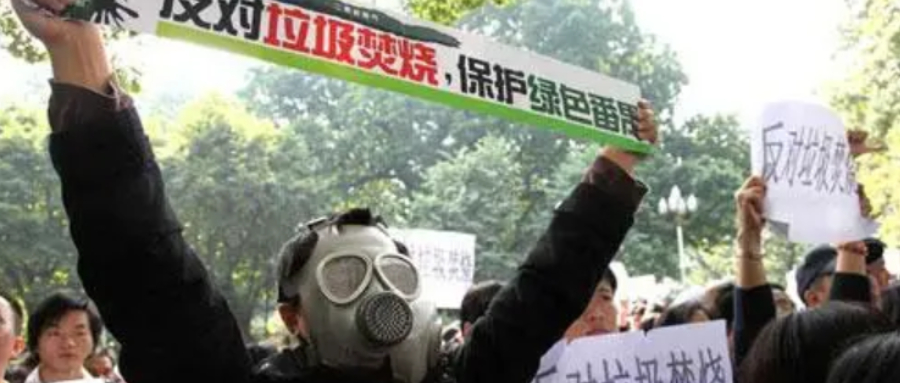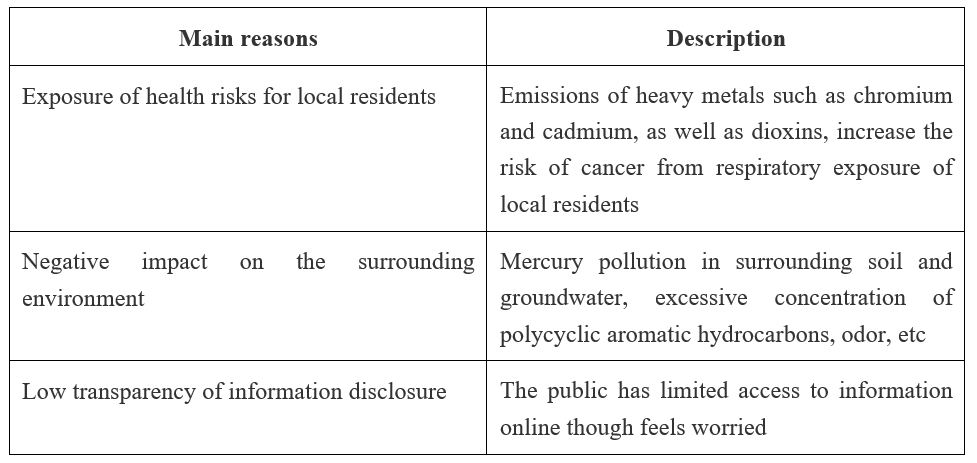

With the rapid development of urbanization and industrialization in China, municipal waste has become a major problem of sustainable urban development. From 2010 to 2018, the total volume of municipal waste collected in China increased year by year. The total municipal waste volume reached 228.018 million tons by 2018, with a year-on-year increase of 5.95% [1]. To solve the problems of limited land resources and the increasing quantity of Municipal Solid Waste (MSW), a large number of incineration plants have been built in cities all over the country. However, as waste sorting was not yet popular and dioxin emissions from many incineration plants could not reach the standard steadily, the public expressed their doubts and opposition to waste incineration projects through protests and other behaviors. The “not in my back yard” effect [2] has become an important issue in the site selection of waste incineration plants in China. The Administrative Regulations on the Application of Automatic Monitoring Data of Domestic Waste Incineration Power Plants (The Administrative Regulations) [3] has been implemented since January 1 this year, which strengthened the requirements on pollution information monitoring of waste incineration industry. But, will it reduce the public's concern and alleviate the “not in my back yard” effect?
The reasons why waste incineration projects would lead to the “not in my back yard” effect
Table 1. Main reasons for the “not in my back yard” effect of local residents towards waste incineration plants [4][5]

Table 1 summarizes three main reasons for local residents' “not in my back yard” effect towards the construction of waste incineration plants, including exposure of health risk for local residents, negative impact on the surrounding environment and low transparency of information disclosure. This article will mainly discuss information disclosure.
According to the "Environmental Responsibility Fulfillment Observation Report" jointly issued by Wuhu Ecology Center and Institute of Public and Environmental Affairs (IPE), only 163 of the 428 waste incineration plants in operation in the country have disclosed information on their websites, and only 61 of them have disclosed information on the surrounding environmental quality; 69 have disclosed the automatic monitoring data of flue gas; 99 of them have disclosed the monitoring data of flue gas dioxins [6]. The low transparency of information disclosure led to the lack of the public knowledge. It was difficult for the public to learn the operation status of the incineration plants and the pollutant discharge situation, making it difficult to judge whether their own health and life were negatively affected. With that many doubts, it is inevitable to have “not in my back yard” mood.
The difficulty with disclosure
The Environmental Protection Law has the highest legal effect in China's environmental legal system, but it only "encourages" enterprises to voluntarily disclose environmental information. The Measures for Environmental Information Disclosure of Enterprises and Public Institutions implemented in 2015 only requires businesses and public institutions to disclose their environmental information in accordance with the principle of compulsory disclosure and voluntary disclosure, although it mentions the channels for government information disclosure and what information should be disclosed by key pollutants-discharging units.
According to Article 8 of the Measures for Environmental Information Disclosure of Enterprises and Public Institutions, waste incineration plants should be included in key pollutant discharging units. However, the reality is that many local environmental protection departments believed that waste incineration plants did not belong to "pollutant centralized disposal units", which led to some environmental protection departments not including waste incineration plants in the list of key pollutant discharge units and failing to disclose pollutant discharge information on official online platforms as required [7]. Due to the different requirements of environmental protection departments for information disclosure of incineration enterprises, enterprises had concerns about disclosure of pollutant discharge data and information, and thus remained cautious.
Can The Administrative Regulations mitigate the“not in my back yard” effect?
The Administrative Regulations requires incineration plants to install and use automatic monitoring equipment and network with ecological and environmental authorities. Automatic monitoring data is the evidence to determine whether a waste incineration plant has environmental violations. The Administrative Regulations also applies automatic monitoring data for environmental law enforcement, which is an important guarantee to promote the disclosure of pollutant discharge data and environmental information of waste incineration plants.
Government officials pointed out that in recent years, the “not in my back yard” effect caused by waste incineration projects was becoming increasingly severe, and the Administrative Regulations, aiming to strengthen the environmental regulation of incinerator emissions, was eliminating waste incineration plants that were lacking in technology, low management level and unqualified long-term emission, to promote an efficient and clean operation of incinerators and their harmony with surrounding residents [8].
If waste incineration plants make their pollutant discharge data transparent, real, accurate and effective, the surrounding residents would not express such a strong rejection to their construction and operation. Sam Geall, Associate Faculty at the Science Policy Research Unit (SPRU) at the University of Sussex, UK, believed that most Britons did not have “not in my back yard” mood because of high levels of public participation and transparency in data processing [9]. He said every country in Europe had its own database of "European Pollutant Release and Transfer Registers". Citizens of every country can log on to the database at any time to view data on potentially toxic substances in the atmosphere, groundwater and soil. These figures were independently verified and cross-checked by the Waste Incineration Authority. In addition, residents had the right to read a comprehensive assessment of the environmental impact of a waste incineration plant and can submit a right-to-know application for more information.
Conclusion
Besides the regulations, the Ministry of Ecology and Environment also unveiled a platform for automatic monitoring data of domestic waste incineration power plants (https://ljgk.envsc.cn/) in early January, where the public can check basic information of waste incineration enterprises and automatic monitoring data of pollutants. However, it was limited to the monitoring data of five conventional pollutants in flue gas, which cannot meet the public's need for environmental information on waste incineration plants.
"Fear stems from the unknown". Previously, due to limited information disclosure, it was difficult for the public to learn the operation status and pollutant emission data of waste incineration plants, inevitably leading to their own imagination and a “not in my back yard” mood. Now, China is gradually strengthening environmental supervision for the waste incineration industry, and residents can easily check the automatic monitoring data of the nearby waste incineration plants. Public participation and supervision can lead to amore objective understanding of the local waste incineration plants, effectively reducing uncertainties and suspicion.
Note:
[1]《中国统计年鉴2019》, link:http://www.stats.gov.cn/tjsj/ndsj/2019/indexch.htm
[2] “not in my back yard”, means resistance by local residents concerned about the negative effects of a construction project
[3]《生活垃圾焚烧发电厂自动监测数据应用管理规定》,中华人民共和国生态环境部,link:http://www.mee.gov.cn/xxgk2018/xxgk/xxgk02/201912/t20191202_744979.html
[4]朱阳光,垃圾焚烧厂的公众可接受环境风险水平研究[D].苏州科技学院,2015
[5]杨雪峰,何兴斓,金家栋. 邻避效应的行为逻辑、多重困境及治理策略——基于垃圾焚烧规划选址情景的分析[J].中共杭州市委党校学报,2018(02):48-54.
[6]《428座生活垃圾焚烧厂环境责任履行民间观察报告》,芜湖生态中心,公众环境研究中心,link:http://www.wastecwin.org/sites/default/files/2019nian_qi_ye_she_hui_ze_ren_lu_xing_bao_gao_-wang_luo_ban_.pdf
[7]建议生态环境部统一信息平台公开垃圾焚烧厂的排污信息,生活垃圾焚烧信息平台,link:http://www.waste-cwin.org/node/2694
[8]中华人民共和国生态环境部,生活垃圾焚烧发电厂环境管理进入新阶段-《生活垃圾焚烧发电厂自动监测数据应用管理规定》解读,link:http://www.mee.gov.cn/xxgk2018/xxgk/xxgk15/201912/t20191202_744963.html
[9]观点:我为什么不抗议居住地垃圾焚烧厂?,BBC News,link: https://www.bbc.com/zhongwen/simp/indepth/2014/05/140513_viewpoint_incinerator
Author:Yuan Yating
Translation: Chen Shikai
Proofread: Pan Yiren
This article is an original article of the Rock Environment and Energy Institute. Please contact us to obtain the appropriate authorization to reprint. For cooperation and authorization, please send an email to: liying@reei.org.cn
* This is the translation of an article in Chinese. Should there be any inconsistency between Chinese and English version, the Chinese version shall prevail.




